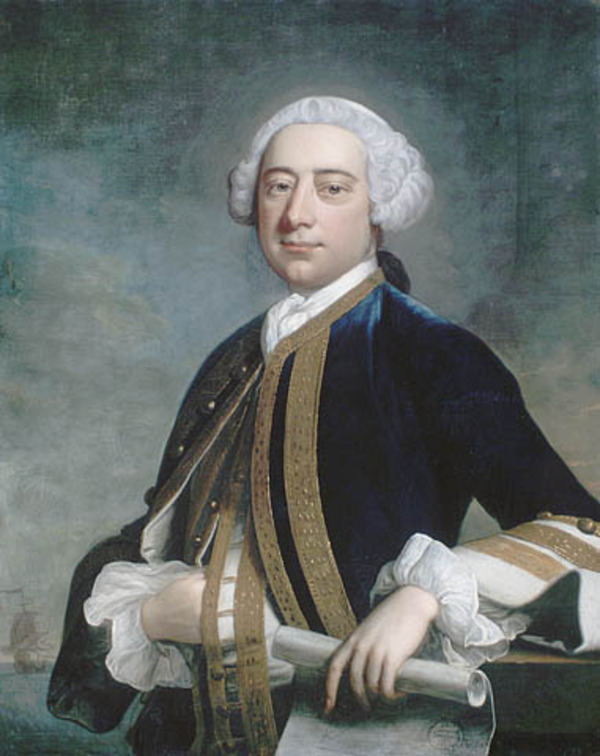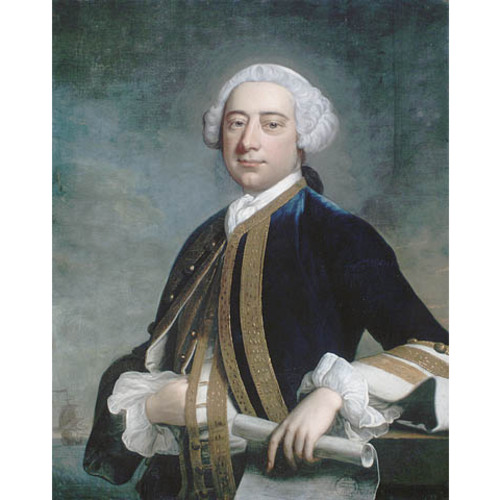DURELL, PHILIP, naval officer; b. 1707 at St Helier, Jersey, and baptized there 25 May 1707; son of John Durell, solicitor general of Jersey, and Elizabeth Corbet; m. his first cousin Madeline Saumarez, secondly a Bristol lady named Skey, thirdly the widow of Captain Wittewronge Taylor; d. 26 Aug. 1766 at Halifax, Nova Scotia, “from eating dolphins.”
After receiving his early education from an aunt, Philip Durell entered the navy through the offices of his uncle, Captain Thomas Durell. He joined the latter’s ship, the 20-gun Sea Horse, as ordinary seaman in 1721. Three years later, as able seaman, he joined the Ludlow Castle (40 guns). During his formative years from 14 to 19 he served on the Newfoundland, Nova Scotia, and New England stations in these two ships. He was commissioned lieutenant in 1731, and while in the West Indies was appointed to the 40-gun Eltham as post captain on 6 Feb. 1742/43 (o.s.).
After returning to England for a refit in 1743, the Eltham sailed in July 1744 for Boston (by way of Antigua) to convoy the mast ships from the Piscataqua River (Me.-N.H.) to England. Before that task could be undertaken, however, Durell’s instructions were changed: in the spring of 1745 he was to join Commodore Peter Warren and William Pepperrell in attacking Louisbourg, Île Royale (Cape Breton Island). Through his local knowledge and surveying skills Durell played an important part in the expedition. While his ship was wintering in Nantasket Roads, Massachusetts, he assisted in formulating Pepperrell’s instructions, and the Eltham was the first ship to join Pepperrell at Canso (Canseau). During the siege Durell assisted in the capture of the Vigilant (Capt. Alexandre de La Maisonfort Du Boisdecourt), which was laden with supplies for the fortress, and, as captain of the Chester, he helped take two French East Indiamen, prizes of enormous value. In October 1745 he returned to England armed with dispatches and a survey of Louisbourg harbour which, according to Warren, “he had been at great pains to make.”
As captain of the Gloucester (50 guns) Durell took part in Rear-Admiral Edward Hawke’s decisive defeat of a French squadron off Cape Ortegal, Spain, on 14 Oct. 1747. He remained in European waters until 1755, when as captain of the Terrible (74 guns) he sailed with Rear-Admiral Francis Holburne’s squadron to reinforce Vice-Admiral Boscawen off Louisbourg and Newfoundland. After returning to England with Boscawen’s fleet in November, Durell took command of the Trident (64 guns) and under Vice-Admiral John Byng participated in the fateful action of 20 May 1756 off Minorca that ended in Byng’s failure to engage the enemy.
On 15 Jan. 1758 Durell hoisted his commodore’s broad pendant in the frigate Diana to be Boscawen’s third in command for the slated attack on Louisbourg. Finding himself senior naval officer on his arrival at New York on 7 March, Durell organized the transportation and convoy to Halifax of the troops. Sailing on 4 May, he arrived at Halifax on 17 May, shifted his broad pendant to the Princess Amelia (80 guns), and sailed for Louisbourg as soon as weather permitted, on 28 May. He played an important part in the capture of the fortress through his advice regarding the place and time of the landing in Gabarus Bay. Surf conditions made this a critical decision. Durell advised postponement twice, on 5 and 7 June. In the small hours of 8 June he took his barge within pistol shot of the breastworks “and found there was a Surf on the Shore, but not such as to prevent Boats landing.” Just after sunrise, having confirmed his opinion, he advised Major-General Jeffery Amherst* accordingly, and the disembarkation began.
On 8 July 1758 Durell was promoted rear-admiral of the blue, and remained in North America as commander-in-chief for the winter months. During this time he carried out instructions “to fix on a proper place here for building a Careening Wharf and erecting a Convenioncior [sic] for refitting his Majesty’s Ships.” Boscawen had hired a wharf at Halifax in 1755, and Charles Holmes had appointed a storekeeper in 1756, but these had been temporary measures. In 1757 the admiralty had finally recognized a need for permanent facilities, but neither Holburne nor Lord Colvill could spare the time and effort needed to prepare a proper site. Durell examined the alternatives and in December 1758 selected land at Gorham’s Point in present Halifax. Additional land was acquired in February 1759, and by mid-March two storehouses and a storekeeper’s office were built, and contracts were drawn up for the careening wharf, capstan house, and adjoining storehouses.
Boscawen and Pitt had instructed Durell to get his squadron ready for sea as early as possible in the spring and to prevent French reinforcements from reaching Quebec. Despite a hard winter all his ships were ready by 8 April 1759, but when Major-General Wolfe and Vice-Admiral Charles Saunders* arrived in Halifax on 30 April they found Durell still in port. Even though the ships were at single anchor, awaiting only a favourable wind, Wolfe was displeased. Durell’s peers in the naval service, however, did not in the end find fault with him. Ice conditions that spring had been particularly severe, and ships were unable to get into the Gulf of St Lawrence or Louisbourg harbour as late as mid-April. Durell had postponed sailing until there was a reasonable chance of getting into the gulf. In the interim he had sent John Rous, who had more local knowledge than any other captain in his squadron, to Canso to watch for French ships and for the improvement of ice conditions. But while an overwhelming British naval strength was concentrating in Halifax a small French squadron was sailing unmolested through leads in the pack ice that still pervaded the gulf; yet there is nothing to substantiate a modern suggestion that Durell had a superstitious fear of the ice. He simply knew too well the difficulties of ice navigation. He had been with Boscawen in 1755 on a vain search for the French fleet in these same waters, and had seen him incur such a loss of men through sickness that the squadron could not remain at sea. In 1759 Durell saved his ships and men to lead the British fleet up the St Lawrence. His judgement had been that of a prudent seaman with far better knowledge of North American waters than most of his contemporaries. Perhaps he did not possess the decisive qualities of a great commander-in-chief, but it is difficult to fault his course of action as a subordinate commander.
One of the officers who sailed from Halifax with Durell on 5 May was James Cook*, master of the Pembroke (Capt. John Simcoe). Assisted by charts which the Alcide (Capt. James Douglas) had captured, Cook surveyed the Traverse, the passage south-east of the Île d’Orléans, and thus removed the last obstacle to reaching Quebec – one the French had deemed impossible to overcome. As Saunders’ second in command, Durell remained between Île d’Orléans and Île Madame to guard the Traverse during the siege.
After the capture of Quebec in September 1759 he returned to England. He had been promoted rear-admiral of the red on 14 Feb. 1759, and on 14 June 1761 he was appointed port admiral of Plymouth. On 21 Oct. 1762 he was promoted vice-admiral of the blue and in 1766 was named commander-in-chief of the North America station in succession to Colvill. During his passage to Halifax he fell ill, and he died four days after his arrival. He was buried on 27 Aug. 1766 from St Paul’s Church, Halifax, where his hatchment is still to be seen.
Portraits of Durell are in the Saumarez Manor, Jersey, the City Museum and Art Gallery in Plymouth, England, and St Paul’s Church, Halifax. Several photographs of paintings are in the PANS.
BM, K. Top., CXIX, 87. 88(2) (copies in PAC). Priaulx Library (St Peter Port, Guernsey, C.I.), ms Coll. PRO, Adm. 1/480; 1/481, ff.41, 140, 530–31, 597–98; 1/482, f.530; 1/1694; 1/1701; 1/2453; 1/2654–55; 8/14–15; 50/3; 50/7, ff.185–227; 51/309; 51/4147. [Philip Durell], “An accurate plan of the River St. Lawrence . . . drawn from the original by Wm. Roberts,” RSCT, 3rd ser., XIX (1925), sect.ii, 152; A particular account of the taking cape Breton . . . (London, 1745). Logs of the conquest (Wood). G. R. Balleine, A biographical dictionary of Jersey (London, New York, [1948]). Charnock, Biographia navalis, V, 167–70. G.B., Adm., Commissioned sea officers, 1660–1815. Corbett, England in the Seven Years’ War, I. Gipson, British empire before the American revolution, VI. G. S. Graham, Empire of the north Atlantic: the maritime struggle for North America (London, Toronto, 1950). R. V. Harris, The Church of Saint Paul in Halifax, Nova Scotia: 1749–1949 (Toronto, 1949). Rawlyk, Yankees at Louisbourg. Robin Reilly, The rest to fortune: the life of Major-General James Wolfe (London, 1960). The Royal Navy: a history from the earliest times to the present, ed. W. L. Clowes (7v., London, 1897–1903), III. C. B. Fergusson, “Durells in eighteenth century Canadian history,” Dal. Rev., XXXV (1955–56), 16–30. E. A. Smillie, “The achievement of Durell in 1759 (facts relating to Admiral Philip Durell and the St. Lawrence expedition),” RSCT, 3rd ser., XIX (1925), sect.ii, 131–51.
Cite This Article
W. A. B. Douglas, “DURELL, PHILIP,” in Dictionary of Canadian Biography, vol. 3, University of Toronto/Université Laval, 2003–, accessed December 20, 2025, https://www.biographi.ca/en/bio/durell_philip_3E.html.
The citation above shows the format for footnotes and endnotes according to the Chicago manual of style (16th edition). Information to be used in other citation formats:
| Permalink: | https://www.biographi.ca/en/bio/durell_philip_3E.html |
| Author of Article: | W. A. B. Douglas |
| Title of Article: | DURELL, PHILIP |
| Publication Name: | Dictionary of Canadian Biography, vol. 3 |
| Publisher: | University of Toronto/Université Laval |
| Year of publication: | 1974 |
| Year of revision: | 1974 |
| Access Date: | December 20, 2025 |




